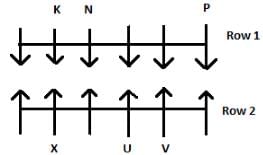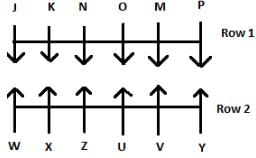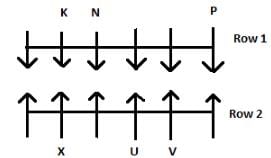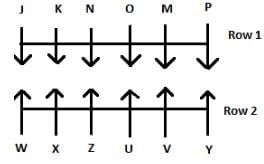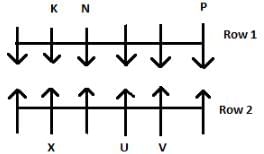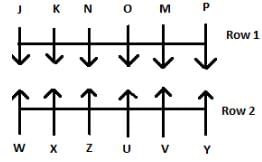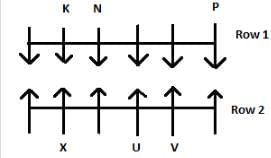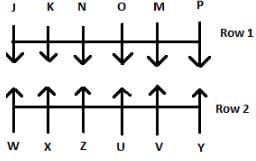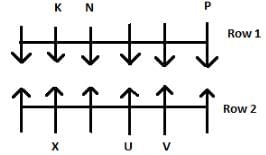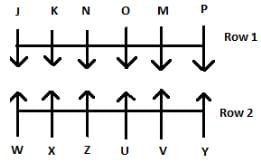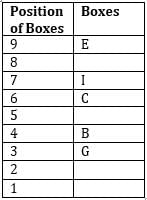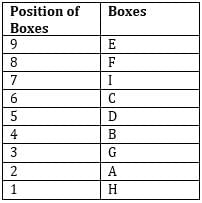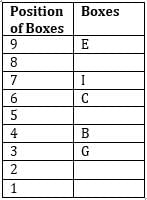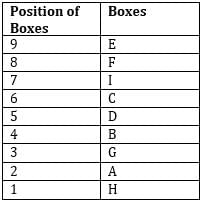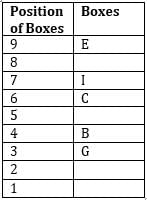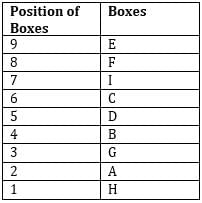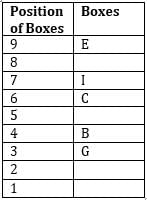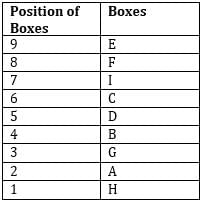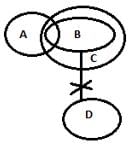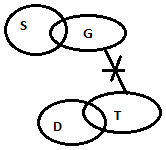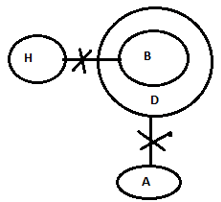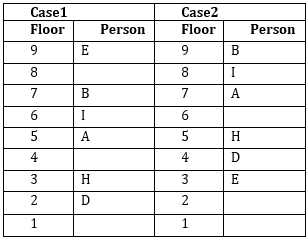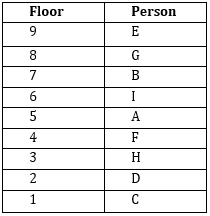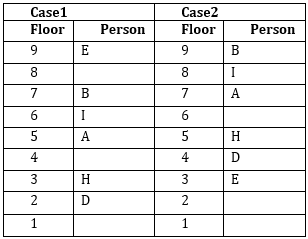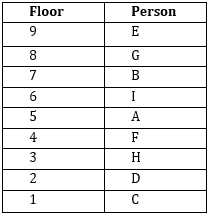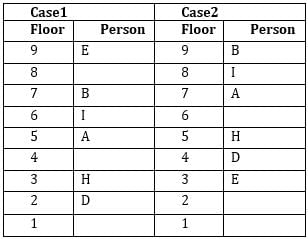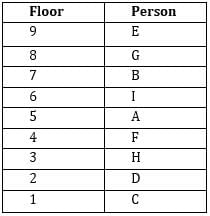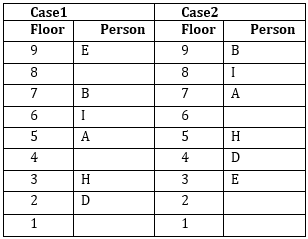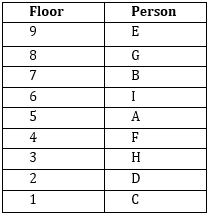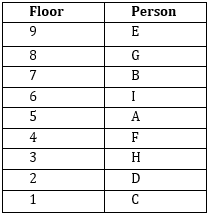NIACL Mock Test - 7 - Insurance MCQ
30 Questions MCQ Test NIACL (New India Insurance) Mock Test Series 2025 - NIACL Mock Test - 7
Study the information and answer the following questions:
Twelve persons are sitting in two parallel rows facing each other. W, X, Z, U, V and Y are sitting in row 2 facing north and J, K, M, N, O and P are sitting in row 1 facing south (not necessarily in the same order). X sits third to the left of V. V sits to the immediate right of U. P faces one of the immediate neighbours of V. Two persons sit between N and P. K sits to the immediate right of N. No one sits to the left of P. Neither N nor P is an immediate neighbour of J. Z does not sit at any end. W does not face P. M sits to the left of O.
Q. Who among the following sits to the immediate left of the one who faces O?
Study the information and answer the following questions:
Twelve persons are sitting in two parallel rows facing each other. W, X, Z, U, V and Y are sitting in row 2 facing north and J, K, M, N, O and P are sitting in row 1 facing south (not necessarily in the same order). X sits third to the left of V. V sits to the immediate right of U. P faces one of the immediate neighbour of V. Two persons sit between N and P. K sits to the immediate right of N. No one sits to the left of P. Neither N nor P is an immediate neighbour of J. Z does not sit at any end. W does not face P. M sits to the left of O.
Q. What is the position of M with respect to K?
Study the information and answer the following questions:
Twelve persons are sitting in two parallel rows facing each other. W, X, Z, U, V and Y are sitting in row 2 facing north and J, K, M, N, O and P are sitting in row 1 facing south (not necessarily in the same order). X sits third to the left of V. V sits to the immediate right of U. P faces one of the immediate neighbour of V. Two persons sit between N and P. K sits to the immediate right of N. No one sits to the left of P. Neither N nor P is an immediate neighbour of J. Z does not sit at any end. W does not face P. M sits to the left of O.
Q. W does not face P. M sits to the left of O. Who faces V?
Study the information and answer the following questions:
Twelve persons are sitting in two parallel rows facing each other. W, X, Z, U, V and Y are sitting in row 2 facing north and J, K, M, N, O and P are sitting in row 1 facing south (not necessarily in the same order).
X sits third to the left of V. V sits to the immediate right of U. P faces one of the immediate neighbours of V. Two persons sit between N and P. K sits to the immediate right of N. No one sits to the left of P. Neither N nor P is an immediate neighbour of J. Z does not sit at any end. W does not face P. M sits to the left of O.
Q. Who among the following sits at the extreme end of the row?
Study the information and answer the following questions:
Twelve persons are sitting in two parallel rows facing each other. W, X, Z, U, V and Y are sitting in row 2 facing north and J, K, M, N, O and P are sitting in row 1 facing south (not necessarily in the same order). X sits third to the left of V. V sits to the immediate right of U. P faces one of the immediate neighbours of V. Two persons sit between N and P. K sits to the immediate right of N. No one sits to the left of P. Neither N nor P is an immediate neighbour of J. Z does not sit at any end. W does not face P. M sits to the left of O.
Q. Four of the following five pairs are alike in a certain way and hence form a group. Who among the following does not belong to that group?
Study the following sequence and answer the given questions.

Q. Which of the following element is 12th to the left of the one which is 12th from the right end of the given arrangement?
Study the following sequence and answer the given questions.

Q. If all the numbers are dropped from the series, which element will be tenth to the right of the one which is seventh from the left end of the new arrangement?
Study the following sequence and answer the given questions.

Q. How many such symbols are there in the given series which are neither immediately preceded by a number nor immediately followed by an alphabet?
Study the following sequence and answer the given questions.

Q. How many such alphabets are there in the given series which are immediately preceded by a number and immediately followed by a vowel?
Study the following sequence and answer the given questions.

Q. What should come in place of question mark (?) in the following series based on the above arrangement?

In each of the question, relationships between some elements are shown in the statements. These statements are followed by conclusions numbered I and II. Read the statements and give the answer.
Statements:
F > R ≥ I > S < K = Y ≤ Z
Conclusions:
I. R>K
II. Z>S
In each of the question, relationships between some elements are shown in the statements. These statements are followed by conclusions numbered I and II. Read the statements and give the answer.
Statements:
E < N ≤ V = L ≤ 0 ≤ P = A
Conclusions:
I. P ≥ N
II. O < E
In each of the question, relationships between some elements are shown in the statements. These statements are followed by conclusions numbered I and II. Read the statements and give the answer.
Statements:
B ≤ L < O > G ≥ E = R ≥ S
Conclusions:
I. S > O
II. G < B
In each of the question, relationships between some elements are shown in the statements. These statements are followed by conclusions numbered I and II. Read the statements and give the answer.
Statements:
T ≥ R = B > L ≥ E = U > O
Conclusions:
I. E < T
II. O < L
In each of the question, relationships between some elements are shown in the statements. These statements are followed by conclusions numbered I and II. Read the statements and give the answer.
Statements:
R = A ≥ F = I > C ; T > R ≤ Z
Conclusions:
I. Z > F
II. I = Z
Study the information and answer the following questions:
Nine boxes A, B, C, D, E, F, G, H and I are placed one above the other but not necessarily in the same order (not necessarily in the same order). Box B is placed immediately above Box G. Three Boxes are placed between Box G and Box I. Box C is placed immediately below Box I. Only one box is placed between Box I and Box E, which is on top. Two boxes are placed between Box A and Box D. Box A is below Box G. Box F is placed above Box H.
Q. How many boxes are placed between Box H and Box F?
Study the information and answer the following questions:
Nine boxes A, B, C, D, E, F, G, H and I are placed one above the other but not necessarily in the same order (not necessarily in the same order). Box B is placed immediately above Box G. Three Boxes are placed between Box G and Box I. Box C is placed immediately below Box I. Only one box is placed between Box I and Box E, which is on top. Two boxes are placed between Box A and Box D. Box A is below Box G. Box F is placed above Box H.
Q. Which box is placed at the bottom?
Study the information and answer the following questions:
Nine boxes A, B, C, D, E, F, G, H and I are placed one above the other but not necessarily in the same order (not necessarily in the same order). Box B is placed immediately above Box G. Three Boxes are placed between Box G and Box I. Box C is placed immediately below Box I. Only one box is placed between Box I and Box E, which is on top. Two boxes are placed between Box A and Box D. Box A is below Box G. Box F is placed above Box H.
Q. Which box is placed at the fourth position from bottom?
Study the information and answer the following questions:
Nine boxes A, B, C, D, E, F, G, H and I are placed one above the other but not necessarily in the same order (not necessarily in the same order). Box B is placed immediately above Box G. Three Boxes are placed between Box G and Box I. Box C is placed immediately below Box I. Only one box is placed between Box I and Box E, which is on top. Two boxes are placed between Box A and Box D. Box A is below Box G. Box F is placed above Box H.
Q. Which box is placed immediately above Box F?
Study the information and answer the following questions:
Nine boxes A, B, C, D, E, F, G, H and I are placed one above the other but not necessarily in the same order (not necessarily in the same order). Box B is placed immediately above Box G. Three Boxes are placed between Box G and Box I. Box C is placed immediately below Box I. Only one box is placed between Box I and Box E, which is on top. Two boxes are placed between Box A and Box D. Box A is below Box G. Box F is placed above Box H.
Q. Which of the following statements is/are true?
In each of the questions below are given some statements followed by two conclusions. You have to take the given statements to be true even if they seem to be at variance with commonly known facts. Read all the conclusions and then decide which of the given conclusions logically follows from the given statements, disregarding commonly known facts. Give answer
Statements:
Some A are B
All B are C
No B is D
Conclusions:
I. No D is C
II. Some A is not D
In each of the questions below are given some statements followed by two conclusions. You have to take the given statements to be true even if they seem to be at variance with commonly known facts. Read all the conclusions and then decide which of the given conclusions logically follows from the given statements, disregarding commonly known facts. Give answer
Statements:
All P is Q
Some Q is T
All T is R
Conclusions:
I. All R is Q
II. Some P is R
In each of the questions below are given some statements followed by two conclusions. You have to take the given statements to be true even if they seem to be at variance with commonly known facts. Read all the conclusions and then decide which of the given conclusions logically follows from the given statements, disregarding commonly known facts. Give answer
Statements:
Some J is K
Some K is M
All M is N
Conclusions:
I. Some N are J
II. Some J are not N
In each of the questions below are given some statements followed by two conclusions. You have to take the given statements to be true even if they seem to be at variance with commonly known facts. Read all the conclusions and then decide which of the given conclusions logically follows from the given statements, disregarding commonly known facts. Give answer
Statements:
Some S is G
No G is T
Some T is D
Conclusions:
I. Some D can be G
II. Some S can never be D
In each of the questions below are given some statements followed by two conclusions. You have to take the given statements to be true even if they seem to be at variance with commonly known facts. Read all the conclusions and then decide which of the given conclusions logically follows from the given statements, disregarding commonly known facts. Give answer
Statements:
No H is B
All B are D
No D is A
Conclusions:
I. Some H can be A
II. Some D can be H
Study the following information carefully and answer the question given below-
Nine people viz. A, B, C, D, E, F, G, H and I live in a building of nine different floors (but not necessarily in the same order). The ground floor is numbered as 1, the floor just above it is numbered as 2 and so on till top floor which is numbered as 9.
B lives on an odd-numbered floor above floor number 5. Three persons live between B and H. D lives immediately below H. Two persons live between D and A. A lives on one of the floor above H. I live immediately above A. E lives on an odd-numbered floor but not on the ground floor. C does not live on an even-numbered floor. F lives below G but not immediately above C.
Q. Who among the following lives on the top floor?
Study the following information carefully and answer the question given below-
Nine people viz. A, B, C, D, E, F, G, H and I live in a building of nine different floors (but not necessarily in the same order). The ground floor is numbered as 1, the floor just above it is numbered as 2 and so on till top floor which is numbered as 9.
B lives on an odd-numbered floor above floor number 5. Three persons live between B and H. D lives immediately below H. Two persons live between D and A. A lives on one of the floor above H. I live immediately above A. E lives on an odd-numbered floor but not on the ground floor. C does not live on an even-numbered floor. F lives below G but not immediately above C.
Q. Who among the following lives immediately above C?
Study the following information carefully and answer the question given below-
Nine people viz. A, B, C, D, E, F, G, H and I live in a building of nine different floors (but not necessarily in the same order). The ground floor is numbered as 1, the floor just above it is numbered as 2 and so on till top floor which is numbered as 9.
B lives on an odd-numbered floor above floor number 5. Three persons live between B and H. D lives immediately below H. Two persons live between D and A. A lives on one of the floor above H. I live immediately above A. E lives on an odd-numbered floor but not on the ground floor. C does not live on an even-numbered floor. F lives below G but not immediately above C.
Q. How many persons live below D?
Study the following information carefully and answer the question given below-
Nine people viz. A, B, C, D, E, F, G, H and I live in a building of nine different floors (but not necessarily in the same order). The ground floor is numbered as 1, the floor just above it is numbered as 2 and so on till top floor which is numbered as 9.
B lives on an odd-numbered floor above floor number 5. Three persons live between B and H. D lives immediately below H. Two persons live between D and A. A lives on one of the floor above H. I live immediately above A. E lives on an odd-numbered floor but not on the ground floor. C does not live on an even-numbered floor. F lives below G but not immediately above C.
Q. Four of the following five are alike in a certain way and hence form a group. Who among the following does not belong to that group?
Study the following information carefully and answer the question given below-
Nine people viz. A, B, C, D, E, F, G, H and I live in a building of nine different floors (but not necessarily in the same order). The ground floor is numbered as 1, the floor just above it is numbered as 2 and so on till top floor which is numbered as 9.
B lives on an odd-numbered floor above floor number 5. Three persons live between B and H. D lives immediately below H. Two persons live between D and A. A lives on one of the floor above H. I live immediately above A. E lives on an odd-numbered floor but not on the ground floor. C does not live on an even-numbered floor. F lives below G but not immediately above C.
Q. Who among the following lives on the even-numbered floor above I?


